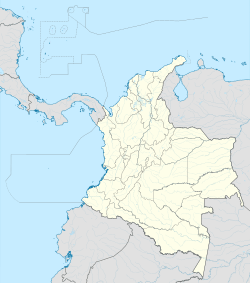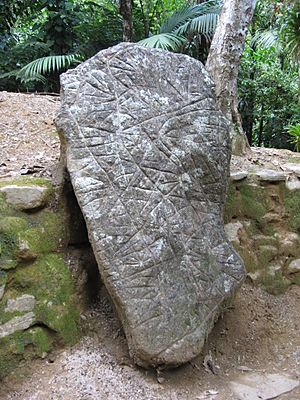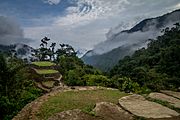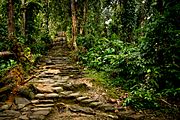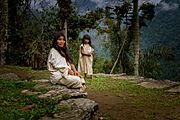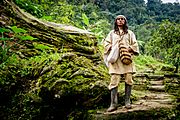Ciudad Perdida facts for kids
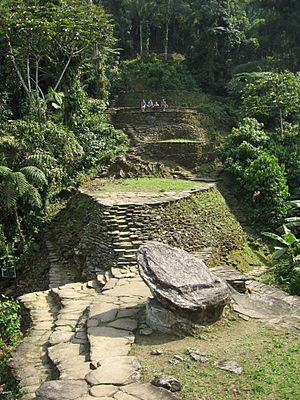
View of the central area of the city. Wooden structures once stood on the stone platforms.
|
|
| Alternative name | Teyuna, Buritaca-200 |
|---|---|
| Location | Magdalena Department, Colombia |
| Region | Sierra Nevada de Santa Marta |
| Coordinates | 11°2′16.79″N 73°55′30.69″W / 11.0379972°N 73.9251917°W |
| Type | Settlement |
Ciudad Perdida is an ancient city located in the Sierra Nevada de Santa Marta mountains of Colombia. Its name means "lost city" in Spanish. It is also known as Teyuna or Buritaca-200.
Experts believe Ciudad Perdida was built around 800 CE. This means it is about 650 years older than the famous site of Machu Picchu. The city has 169 stone terraces carved into the mountain. It also features a network of tiled roads and several small circular plazas. To reach the entrance, you must climb about 1,200 stone steps through the thick jungle.
Contents
How the Lost City Was Found
Ciudad Perdida was discovered in 1972 by a group of local treasure hunters called Los Sepúlvedas. They made one of the biggest archaeological finds in modern times.
The Sepúlveda family often hunted in the forests. One day, they shot a wild turkey. While looking for the turkey, they saw it had fallen near some stone steps going up the mountainside. They followed the steps and found an old, abandoned city. They first called it "Green Hell" or "Wide Set."
Soon, gold items and pottery from Ciudad Perdida started appearing in local markets. This caught the attention of archaeologists. A team, led by the director of the Instituto Colombiano de Antropología, arrived at the site in 1976. The city was carefully rebuilt between 1976 and 1982.
Local tribes, especially the Kogi people, say they visited Ciudad Perdida regularly before it became widely known. They kept it a secret. They call the city "Teyuna." They believe it was the main city of many villages built by their ancestors, the Tairona people.
Ciudad Perdida is impressive, but it is not the only ancient site there. Only about 30-40% of the sites in the Sierra Nevada region have been explored. However, new technology like lidar is helping to find more of these hidden places.
History of the City
Ciudad Perdida was built around 800 CE. It was likely an important center for politics and making things along the Buritaca River. Between 2,000 and 8,000 people might have lived there. The Tairona people originally lived in this city. The Kogi people, who are descendants of the Tairona, say their ancestors lived there for thousands of years. They lived there until the time of the Spanish conquistadors.
The Tairona people were forced to leave Ciudad Perdida in the 1500s. This happened after many years of trade and fighting with the Spanish.
Ancient Tribes
Indigenous peoples had built advanced communities 1,500 years before the Spanish arrived. These communities were connected by stone paths. These paths helped them trade food and items made of gold, stone, and clay. The people used the many foods and resources found in this mountainous area near the sea.
They grew vegetables like tomatoes and corn in their gardens. They also grew fruits like avocado, pineapple, and guava. Because they lived close to the ocean, they had a lot of seafood. Children learned stories and legends from their elders. They were also taught how to make fabrics for clothes and special bags called mochilas. Everyone admired the warriors who protected their people from the Spanish.
There were many Tairona groups and villages spread across the mountains and beaches. They all traded and worked together. When the Spanish arrived in 1514, they wanted to take control. The Spanish tried to force the Tairona to obey them and their church. They threatened to take their people, women, and children as slaves. They also wanted to take their goods.
The Tairona people were strong warriors. They fought against the Spanish for almost 100 years. For many years, they held their ground despite the harsh treatment from the Europeans. The Tairona people, like the Kogi today, were not violent. They believed in kindness and equality. The Tairona people lived to protect the Earth for everyone.
As the European settlers moved into their land, they began to enslave the native people who fished and collected salt on the coast. The Tairona people in the mountains needed the fish and salt from the coast. They told escaped enslaved Tairona members to go back and offer the Europeans gifts of gold to make them happy. The Europeans took the gold but became even more hostile. The Tairona resisted for many years but were eventually forced to leave their homes in the 1500s.
The effects of the Spanish colonization are still seen today. Over the years, the Europeans took more and more of the gold made by the indigenous people. Much of that gold is now in museums in Europe. This leaves the current descendant tribes, such as the Kogi, Arsarios, Arhuacos, Kankwamos, and Chimilas, without their ancestors' gold.
The Kogi people live in one of the last pre-Columbian settlements. They have mostly kept the ways of the Tairona people since they were forced out by the Spanish. The Kogi can share insights about the Tairona, but it is important to remember they are different from the people who lived 500 years ago. The Kogi believe that everything buried in Ciudad Perdida helps bring peace and balance to the world. They successfully worked with the Colombian government to get back the rights to their ancestral land. Now, groups like the Global Heritage Fund help protect this historic site.
Safety and Access
The area around Ciudad Perdida was once affected by the Colombian armed conflict. This involved the Colombian National Army, right-wing groups, and left-wing groups like the National Liberation Army (ELN) and Revolutionary Armed Forces of Colombia (FARC).
In 2003, the ELN kidnapped eight foreign tourists visiting Ciudad Perdida. They demanded an investigation into human rights issues. The ELN released the last hostages three months later. After this, other groups continued to cause problems in the area for a while.
However, the area has been peaceful for some time now. It is considered safe for visitors.
Visiting Ciudad Perdida
Tourist hikes to Ciudad Perdida started again in 2005. There have been no problems since then. The Colombian Army actively patrols the area, making it safe for visitors. There have been no more kidnappings.
Since 2009, the non-profit organization Global Heritage Fund (GHF) has been working at Ciudad Perdida. They help protect the historic site from weather, plants, neglect, looting, and too much tourism. GHF works to create a plan for the area. They also document and protect the ancient features of Ciudad Perdida. They involve the local indigenous communities in preserving and developing the site.
A 4-day hike to the lost city costs about US$334. This price is set by the communities living near the trail. It is a moderately difficult hike. The total walk is about 44 kilometers (27 miles). It requires good fitness. The hike includes crossing several rivers and climbing and descending steep paths.
Gallery
See also
 In Spanish: Ciudad Perdida para niños
In Spanish: Ciudad Perdida para niños


